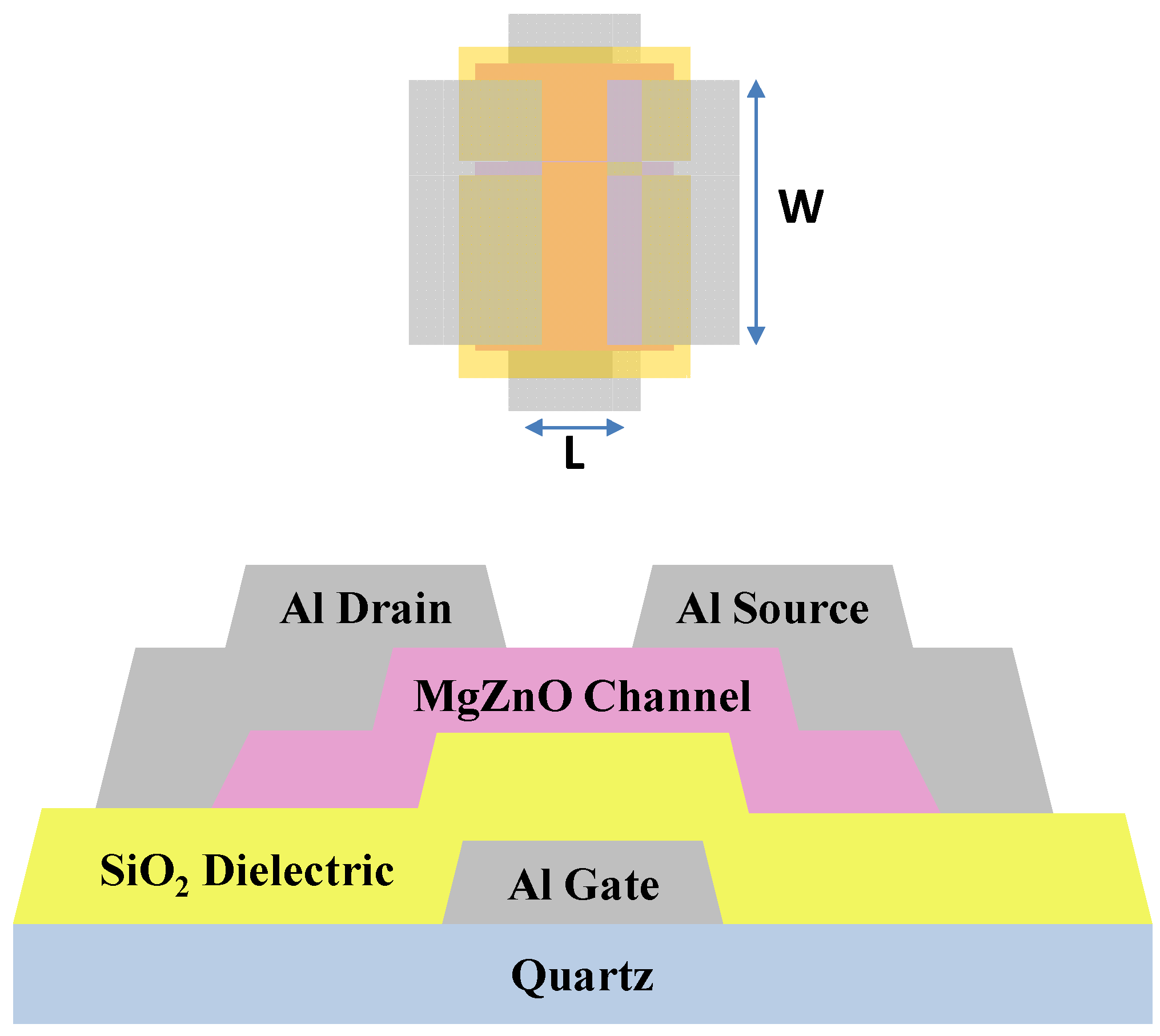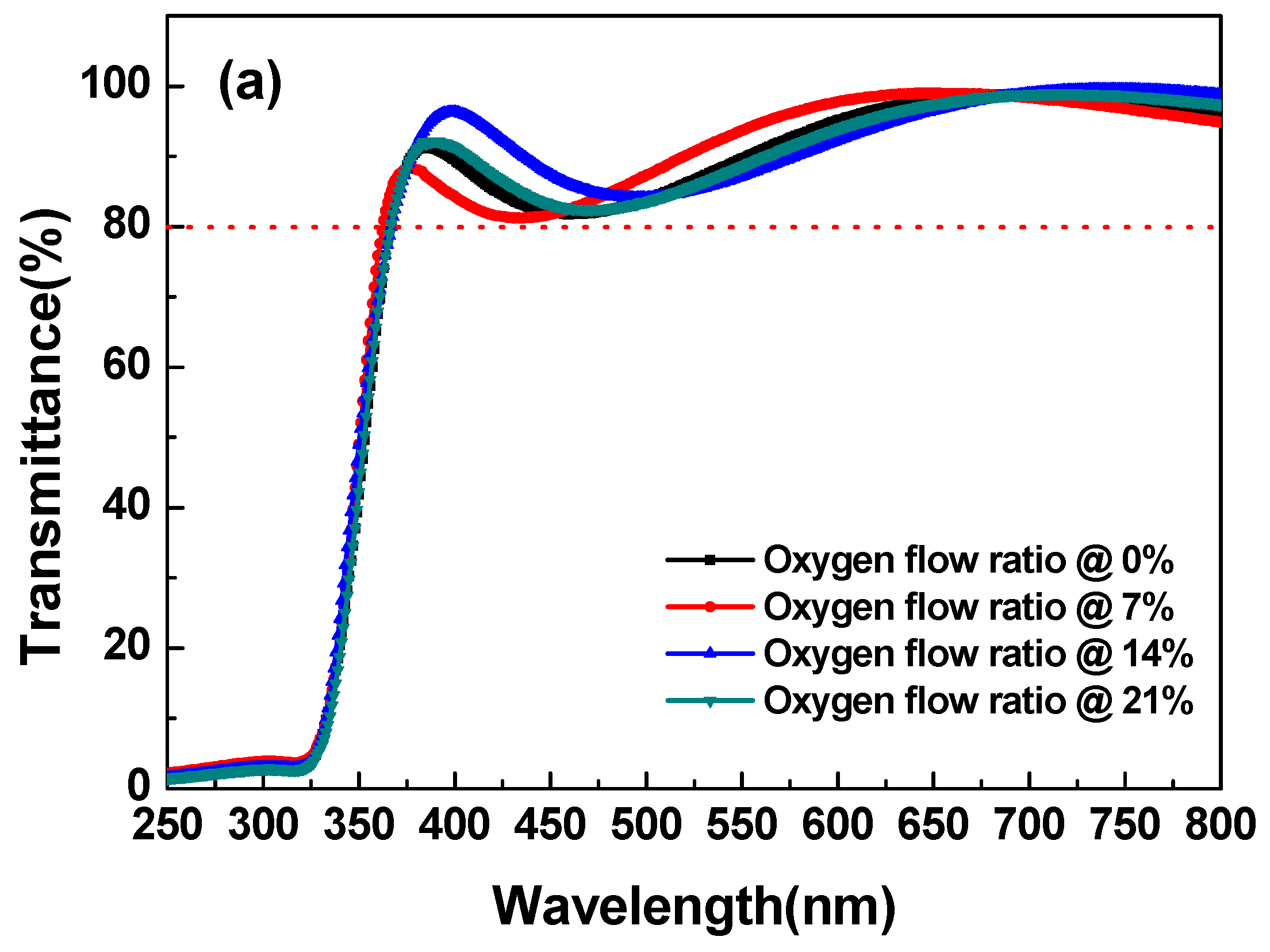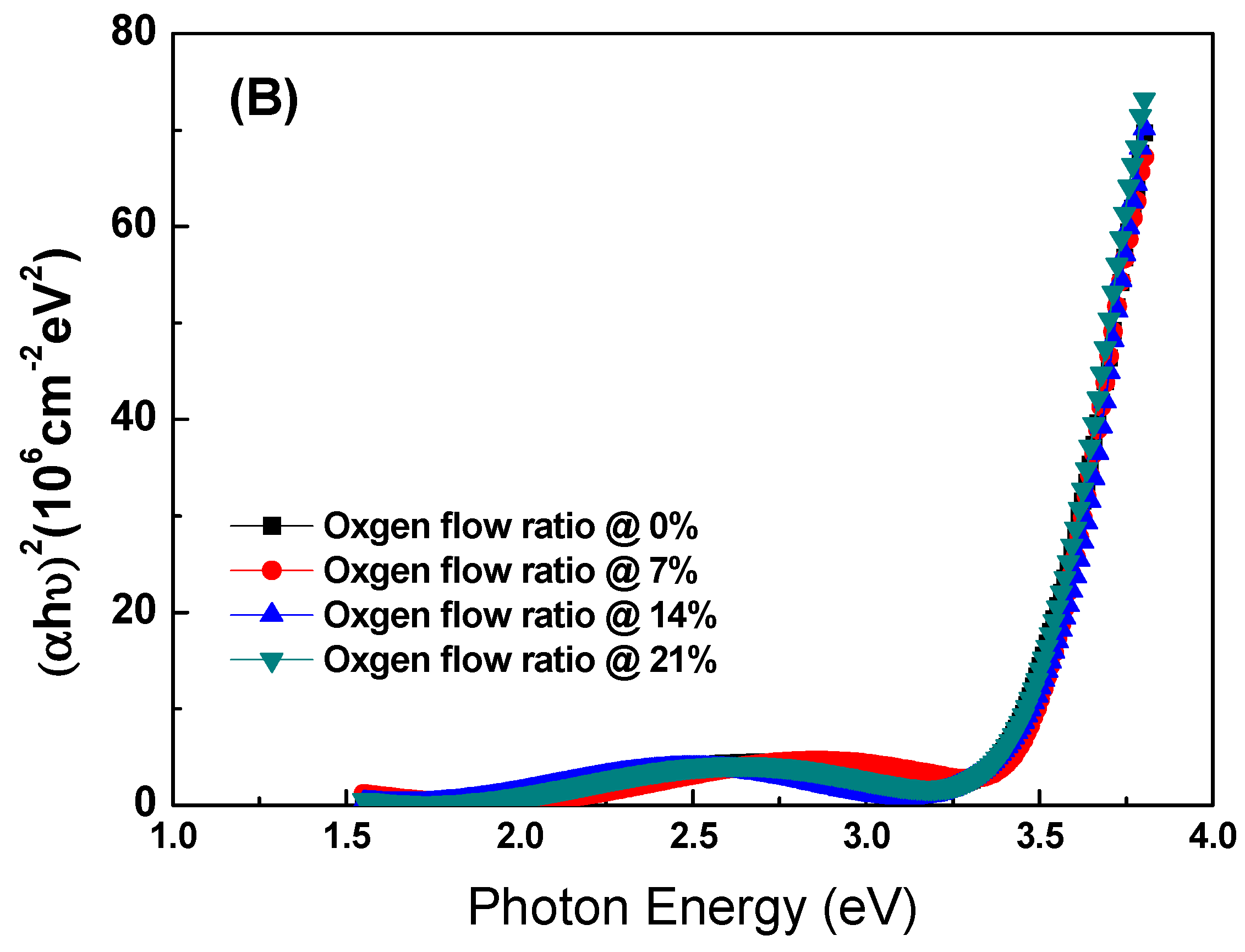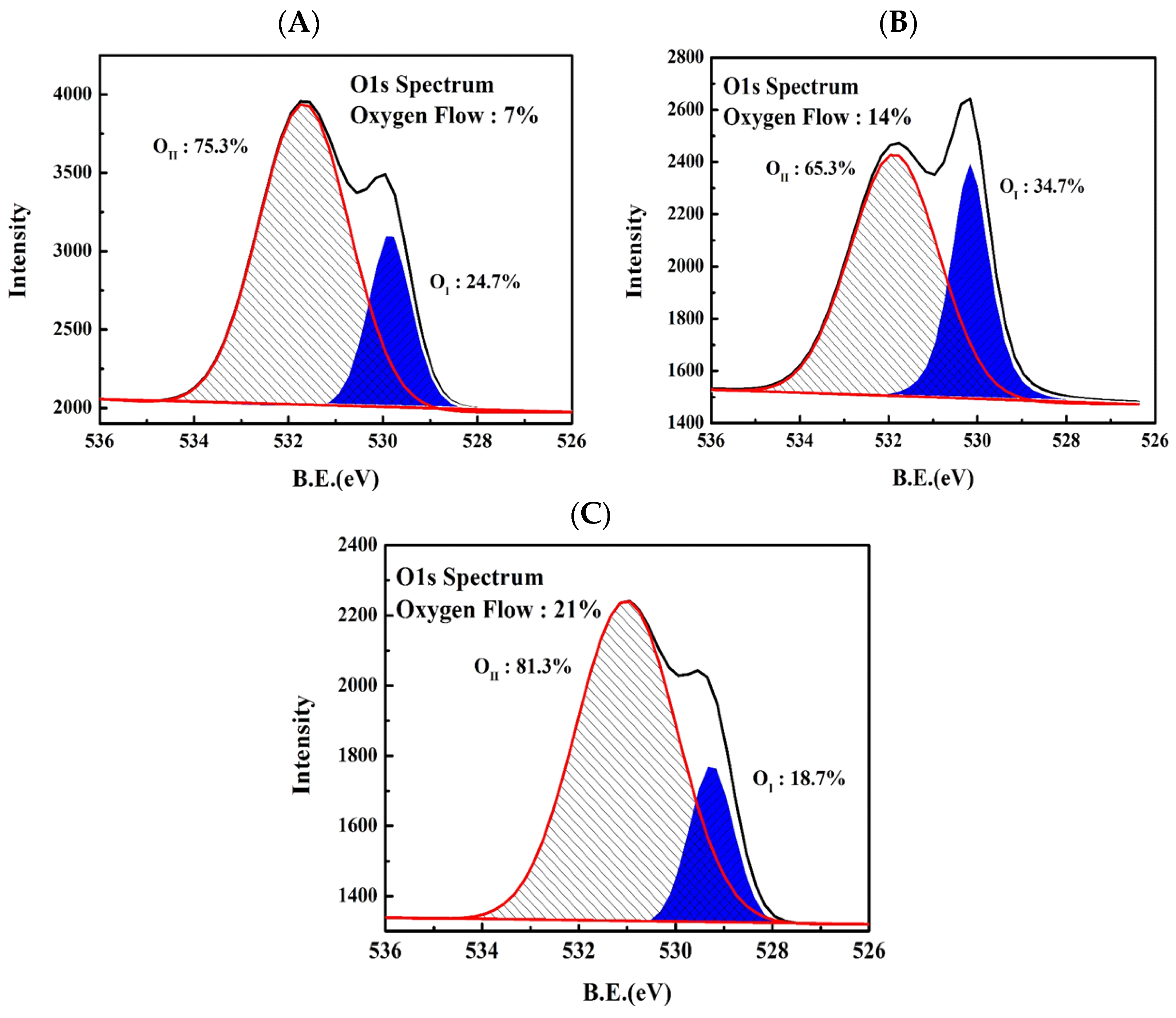High Responsivity MgZnO Ultraviolet Thin-Film Phototransistor Developed Using Radio Frequency Sputtering
Abstract
:1. Introduction
2. Materials and Methods
3. Results and Discussion
4. Conclusions
Acknowledgments
Author Contributions
Conflicts of Interest
References
- Chai, G.; Lupan, O.; Chow, L.; Heinrich, H. Crossed zinc oxide nanorods for ultraviolet radiation detection. Sensor. Actuat. A Phys. 2009, 150, 184–187. [Google Scholar] [CrossRef]
- Osinsky, A.; Gangopadhyay, S.; Gaska, R.; Williams, B.; Khan, M.A.; Kuksenkov, D.; Temkin, H. Low noise p-π-n GaN ultraviolet photodetectors. Appl. Phys. Lett. 1997, 71, 2334–2336. [Google Scholar] [CrossRef]
- Smith, C.A.; Lee, H.W.H.; Leppert, V.J.; Risbud, S.H. Ultraviolet-blue emission and electron-hole states in ZnSe quantum dots. Appl. Phys. Lett. 1999, 75, 1688–1690. [Google Scholar] [CrossRef]
- He, J.H.; Lin, Y.H.; McConney, M.E.; Tsukruk, V.V.; Wang, Z.L.; Bao, G. Enhancing UV photoconductivity of ZnO nanobelt by polyacrylonitrile functionalization. J. Appl. Phys. 2007, 102, 084303. [Google Scholar] [CrossRef]
- Gimenez, A.J.; Yáñez-Limón, J.M.; Seminario, J.M. ZnO–cellulose composite for UV sensing. IEEE Sens. J. 2013, 13, 1301–1306. [Google Scholar] [CrossRef]
- Bae, H.S.; Yoon, M.H.; Kim, J.H.; Im, S. Photodetecting properties of ZnO-based thin-film transistors. Appl. Phys. Lett. 2003, 83, 5313–5315. [Google Scholar] [CrossRef]
- Zan, H.W.; Chen, W.T.; Hsueh, H.W.; Kao, S.C.; Ku, M.C.; Tsai, C.C.; Meng, H.F. Amorphous indium-gallium-zinc-oxide visible-light phototransistor with a polymeric light absorption layer. Appl. Phys. Lett. 2010, 97, 203506. [Google Scholar] [CrossRef]
- Chiu, C.J.; Weng, W.Y.; Hsueh, T.J.; Chang, S.J.; Huang, G.J.; Hsueh, H.T. Ta2O5 Solar-Blind Photodetectors. IEEE Sens. J. 2011, 11, 2372–2373. [Google Scholar] [CrossRef]
- Zhang, S.B.; Wei, S.H.; Zunger, A. Intrinsic n-type versus p-type doping asymmetry and the defect physics of ZnO. Phys. Rev. B 2001, 63, 075205. [Google Scholar] [CrossRef]
- Furuta, M.; Kamada, Y.; Kimura, M.; Hiramatsu, T.; Matsuda, T.; Furuta, H.; Li, C.; Fujita, S.; Hirao, T. Analysis of Hump Characteristics in Thin-Film Transistors With ZnO Channels Deposited by Sputtering at Various Oxygen Partial Pressures. IEEE Electron Device Lett. 2010, 31, 1257–1259. [Google Scholar]
- Kimura, M.; Nakanishi, T.; Nomura, K.; Kamiya, T.; Hosono, H. Trap densities in amorphous-InGaZnO4 thin-film transistors. Appl. Phys. Lett. 2008, 92, 133512. [Google Scholar] [CrossRef]
- Su, L.Y.; Lin, H.Y.; Wang, S.L.; Yeh, Y.H.; Cheng, C.C.; Peng, L.H.; Huang, J.J. Effects of gate-bias stress on ZnO thin-film transistors. J. Soc. Inf. Disp. 2010, 18, 802–806. [Google Scholar] [CrossRef]
- Chin, H.A.; Cheng, I.C.; Huang, C.I.; Wu, Y.R.; Lu, W.S.; Lee, W.L.; Lin, T.S. Two dimensional electron gases in polycrystalline MgZnO/ZnO heterostructures grown by rf-sputtering process. J. Appl. Phys. 2010, 108, 054503. [Google Scholar] [CrossRef]
- Kwon, Y.; Li, Y.; Heo, Y.W.; Jones, M.; Holloway, P.H.; Norton, D.P.; Park, Z.V.; Li, S. Enhancement-mode thin-film field-effect transistor using phosphorus-doped (Zn,Mg)O channel. Appl. Phys. Lett. 2004, 84, 2685–2687. [Google Scholar] [CrossRef]
- Li, C.H.; Tsai, Y.S.; Chen, J.Z. Negative bias temperature instability of Rf-sputtered Mg0.05Zn0.95O thin film transistors with MgO gate dielectrics. Semicond. Sci. Tech. 2011, 26, 105007. [Google Scholar] [CrossRef]
- Wu, H.; Liang, J.; Jin, G.; Lao, Y.; Xu, T. Transparent thin-film transistors using ZnMgO as dielectrics and channel. IEEE Trans. Electron Devices 2007, 54, 2856–2859. [Google Scholar] [CrossRef]
- Wrench, J.S.; Brunell, I.F.; Chalker, P.R.; Jin, J.D.; Shaw, A.; Mitrovic, I.Z.; Hall, S. Compositional tuning of atomic layer deposited MgZnO for thin film transistors. Appl. Phys. Lett. 2014, 105, 202109. [Google Scholar] [CrossRef]
- Hullavarad, S.S.; Dhar, S.; Varughese, B.; Takeuchi, I.; Venkatesan, T.; Vispute, R.D. Realization of Mg (x = 0.15) Zn (1 − x = 0.85) O-based metal-semiconductor-metal UV detector on quartz and sapphire. J. Vac. Sci. Technol. A 2005, 23, 982–985. [Google Scholar] [CrossRef]
- Yang, W.; Vispute, R.D.; Choopun, S.; Sharma, R.P.; Venkatesan, T.; Shen, H. Ultraviolet photoconductive detector based on epitaxial Mg0.34Zn 0.66O thin films. Appl. Phys. Lett. 2001, 78, 2787–2789. [Google Scholar] [CrossRef]
- Koike, K.; Hama, K.; Nakashima, I.; Takada, G.Y.; Ogata, K.I.; Sasa, S.; Inoue, M.; Yano, M. Molecular beam epitaxial growth of wide bandgap ZnMgO alloy films on (111)-oriented Si substrate toward UV-detector applications. J. Cryst. Growth 2005, 278, 288–292. [Google Scholar] [CrossRef]
- Hwang, D.K.; Lee, K.; Kim, J.H.; Im, S.; Park, J.H.; Kim, E. Comparative studies on the stability of polymer versus SiO2 gate dielectrics for pentacene thin-film transistors. Appl. Phys. Lett. 2006, 89, 093507. [Google Scholar] [CrossRef]
- Hong, W.K.; Kim, B.J.; Kim, T.W.; Jo, G.; Song, S.; Kwon, S.S.; Yoon, A.; Stach, E.A.; Lee, T. Electrical properties of ZnO nanowire field effect transistors by surface passivation. Colloid. Surface. A 2008, 313, 378–382. [Google Scholar] [CrossRef]







| Oxygen Ratio | Vt (V) | µeff (cm2/Vs) | On–Off Current Ratio | S.S. | Nt |
|---|---|---|---|---|---|
| 0% | 3.6 ± 0.072 | 2.42 ± 0.048 | 8.4 × 104 ± 1680 | 0.89 ± 0.018 | 1.6 × 1012 |
| 7% | 6.6 ± 0.132 | 2.17 ± 0.043 | 1.2 × 105 ± 2400 | 1.65 ± 0.033 | 2.9 × 1012 |
| 14% | 3.1 ± 0.062 | 5.65 ± 0.113 | 4.4 × 105 ± 8800 | 0.80 ± 0.016 | 1.4 × 1012 |
| 21% | 6.2 ± 0.124 | 3.25 ± 0.065 | 1.5 × 105 ± 3300 | 1.36 ± 0.027 | 2.4 × 1012 |
© 2017 by the authors. Licensee MDPI, Basel, Switzerland. This article is an open access article distributed under the terms and conditions of the Creative Commons Attribution (CC BY) license ( http://creativecommons.org/licenses/by/4.0/).
Share and Cite
Li, J.-Y.; Chang, S.-P.; Hsu, M.-H.; Chang, S.-J. High Responsivity MgZnO Ultraviolet Thin-Film Phototransistor Developed Using Radio Frequency Sputtering. Materials 2017, 10, 126. https://doi.org/10.3390/ma10020126
Li J-Y, Chang S-P, Hsu M-H, Chang S-J. High Responsivity MgZnO Ultraviolet Thin-Film Phototransistor Developed Using Radio Frequency Sputtering. Materials. 2017; 10(2):126. https://doi.org/10.3390/ma10020126
Chicago/Turabian StyleLi, Jyun-Yi, Sheng-Po Chang, Ming-Hung Hsu, and Shoou-Jinn Chang. 2017. "High Responsivity MgZnO Ultraviolet Thin-Film Phototransistor Developed Using Radio Frequency Sputtering" Materials 10, no. 2: 126. https://doi.org/10.3390/ma10020126
APA StyleLi, J.-Y., Chang, S.-P., Hsu, M.-H., & Chang, S.-J. (2017). High Responsivity MgZnO Ultraviolet Thin-Film Phototransistor Developed Using Radio Frequency Sputtering. Materials, 10(2), 126. https://doi.org/10.3390/ma10020126








